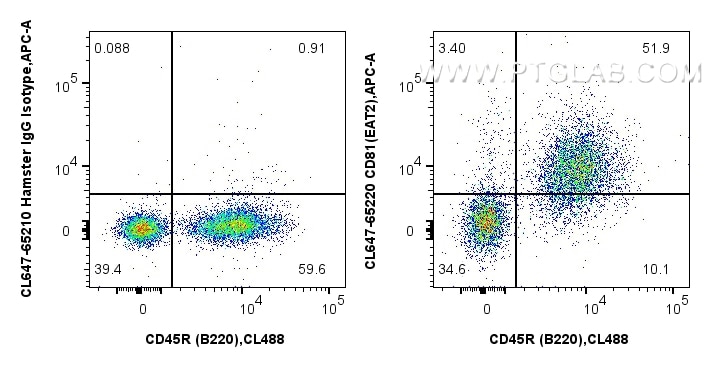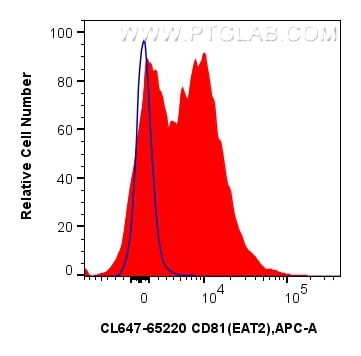Anticorps Monoclonal anti-CD81
CD81 Monoclonal Antibody for FC
Hôte / Isotype
Armenian Hamster / IgG
Réactivité testée
souris
Applications
FC
Conjugaison
CoraLite® Plus 647 Fluorescent Dye
CloneNo.
EAT2
N° de cat : CL647-65220
Synonymes
Galerie de données de validation
Applications testées
| Résultats positifs en cytométrie | splénocytes de souris, |
Dilution recommandée
| Application | Dilution |
|---|---|
| This reagent has been tested for flow cytometric analysis. It is recommended that this reagent should be titrated in each testing system to obtain optimal results. | |
| Sample-dependent, check data in validation data gallery | |
Informations sur le produit
CL647-65220 cible CD81 dans les applications de FC et montre une réactivité avec des échantillons souris
| Réactivité | souris |
| Hôte / Isotype | Armenian Hamster / IgG |
| Clonalité | Monoclonal |
| Type | Anticorps |
| Immunogène | CD81+ mouse B lymphoma 38C13 |
| Nom complet | CD81 antigen |
| Numéro d’acquisition GenBank | BC011433 |
| Symbole du gène | Cd81 |
| Identification du gène (NCBI) | 12520 |
| Conjugaison | CoraLite® Plus 647 Fluorescent Dye |
| Excitation/Emission maxima wavelengths | 654 nm / 674 nm |
| Forme | Liquide |
| Méthode de purification | Purification par protéine G |
| Tampon de stockage | PBS with 0.09% sodium azide and 0.5% BSA |
| Conditions de stockage | Store at 2-8°C. Avoid exposure to light. Stable for one year after shipment. |
Informations générales
CD81 (also known as TAPA1or TSPAN28) is a membrane protein of the tetraspanin superfamily, which are characterized by the presence of four conserved transmembrane regions. Many of these members are expressed on leukocytes and have been implicated in signal transduction, cell-cell interactions, and cellular activation and development. CD81 is involved in signal transduction and cell adhesion in the immune system (PMID: 9597125). CD81 has also been identified as an essential receptor for HCV (hepatitis C virus) (PMID: 21428934).
Protocole
| Product Specific Protocols | |
|---|---|
| FC protocol for CL Plus 647 CD81 antibody CL647-65220 | Download protocol |
| Standard Protocols | |
|---|---|
| Click here to view our Standard Protocols |



